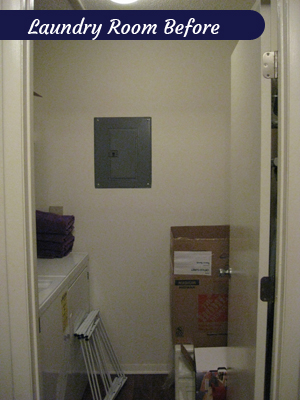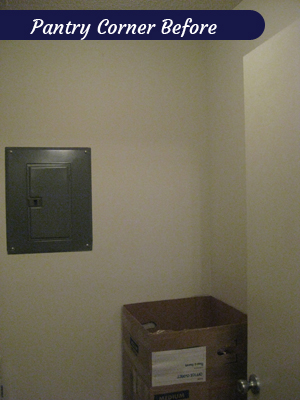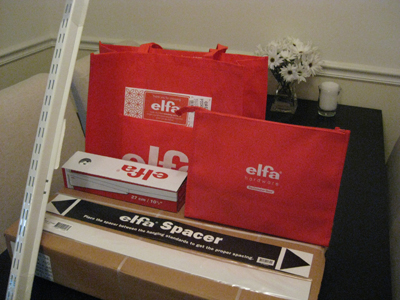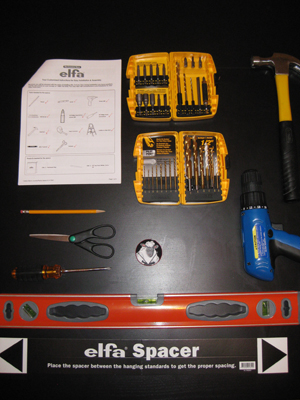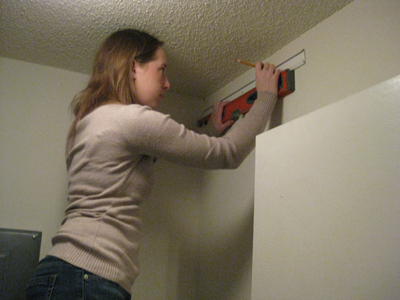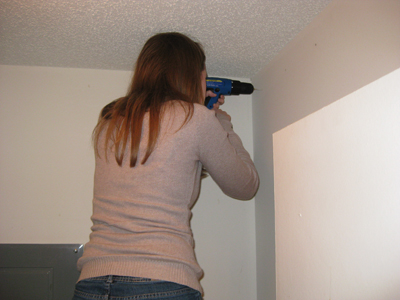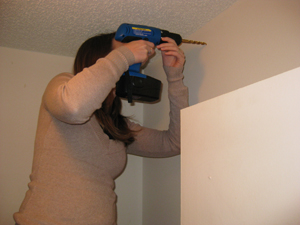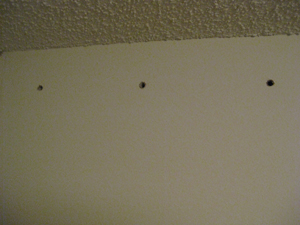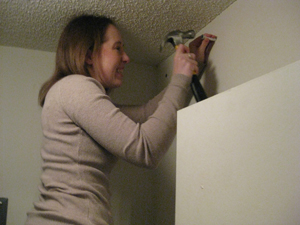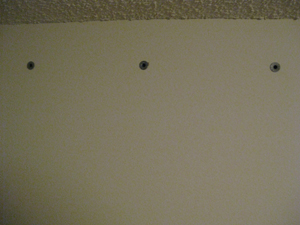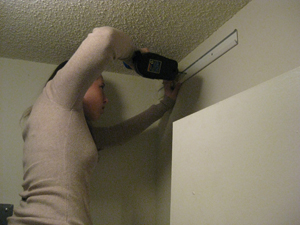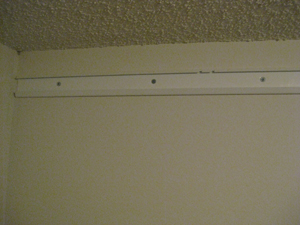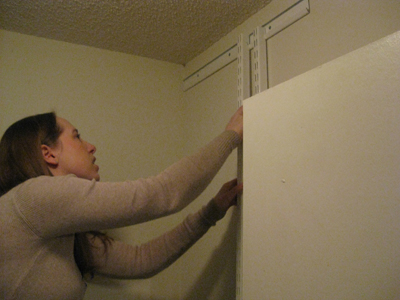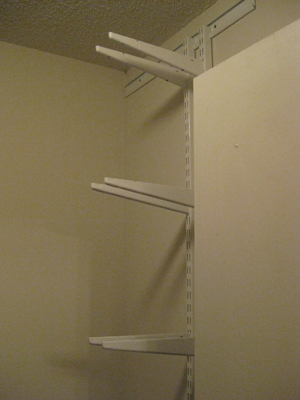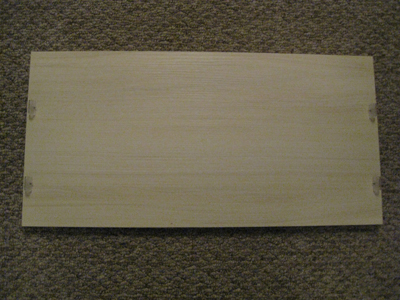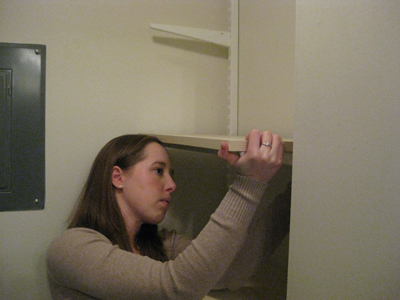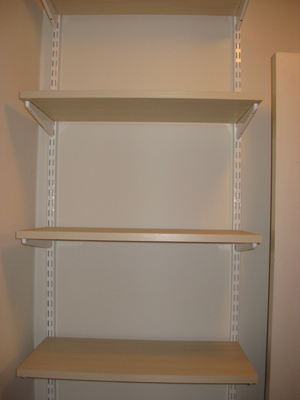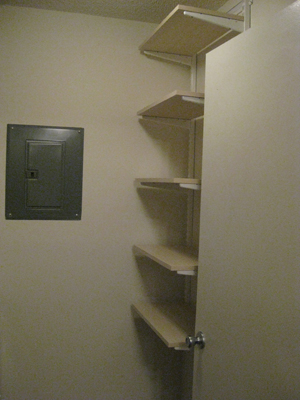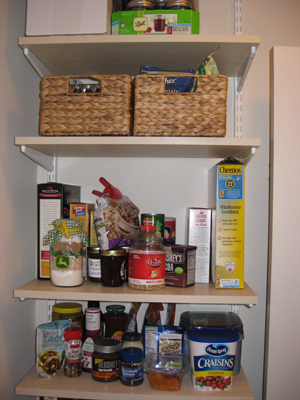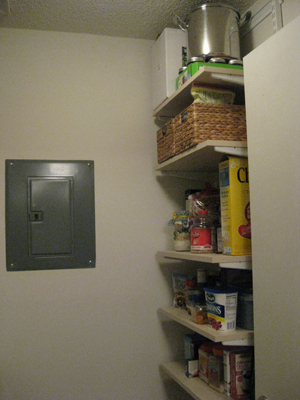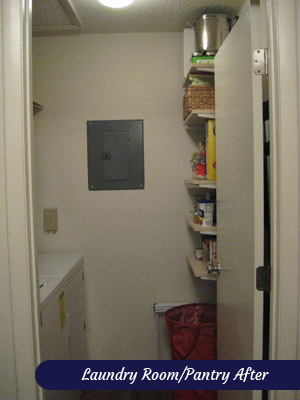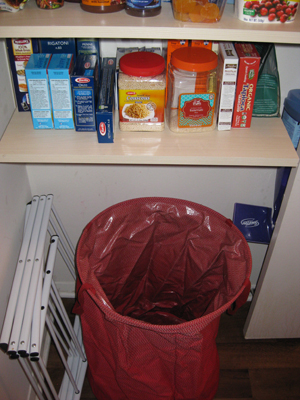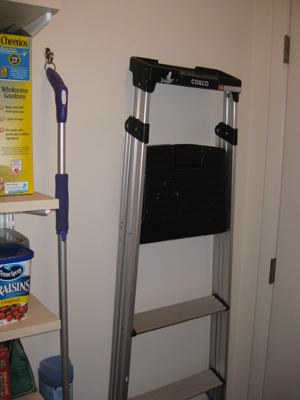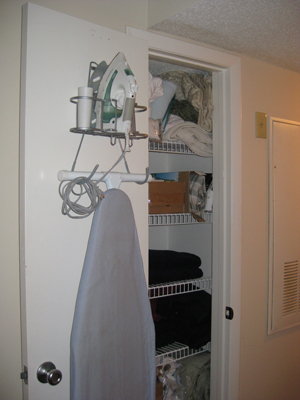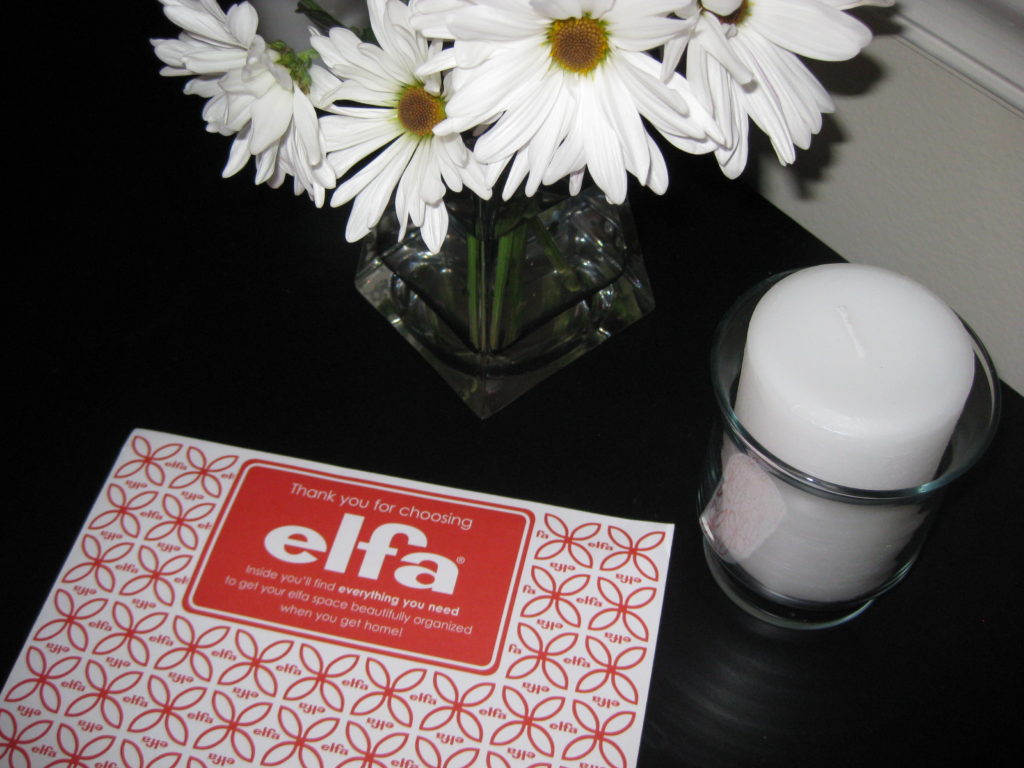Due to all of the time spent on the pantry, as well as a failed mini-project that involved getting a drill bit lodged nearly inextricably in a wall, I didn’t get to this assignment over the weekend. I’ll knock it out on the make-up day later in the month.
Home Improvement
Creating a Pantry
First project of the year completed, and it didn’t even take all weekend! After cleaning out our cart full of non-perishables and placing an order for an elfa system, we were anxious to get the pantry project rolling. Wouldn’t you be, if your laundry closet looked like this?
On Saturday I received a text to say that our order was ready for pickup. Even though everything fit easily into a single cart, the associate was kind enough to take it out to our car and load it into our trunk.
When we got home, we laid everything out on our dining room table.
The large reusable tote held the shelf brackets, the top track cover, and the smaller red bag. The smaller red bag held all of the hardware, which included drywall anchors with screws, wood screws, and independent shelf pins.
After checking to make sure that everything we’d ordered had made it home—and it had—we cleared the table to make room for all of the required tools.
The round thing with a picture of a sheep on it is a tape measure that usually lives in my knitting bag. I couldn’t find our regular metal tape measure, although it ultimately didn’t matter, since we didn’t end up using it for our installation.
We have roughly eight-foot-high ceilings, but we opted to go with a five-foot-high system since we knew we wanted space underneath it for a recycling bin of some kind. We could have gotten one that went floor to ceiling and just chosen not to hang shelves at the bottom, but didn’t see a reason to spend extra money for something we weren’t going to use. (Even if we re-purpose it, I doubt I’ll want to bend over to get things off the lowest shelves and would probably end up putting some kind of box or bin below it anyway.)
Because we weren’t concerned about fitting the vertical pieces exactly between the floor and the ceiling, and because the popcorn texture makes the ceiling uneven, I moved the top track down a couple of inches from the top of the wall. I also moved it away from the corner of the wall by about a half inch. There was no formula to it, I just eyeballed it and then made sure that the track was level before marking the holes.
Using the recommended 1/8″ bit, I drilled three pilot holes where I had marked them.
Since I didn’t hit a stud with any of them (something I’d already checked with a stud finder), I enlarged the holes with a 3/8″ bit…
…and tapped in the drywall anchors.
(I’m laughing here because Justin pointed out that 1) strands of my hair kept getting stuck to the ceiling, and 2) I apparently tend to work with my mouth open, which was making for a lot of funny pictures. About two-thirds of the photos ended up as outtakes, between my dumb faces and crazy hair moments.)
Once I gave up trying not to look goofy, I could concentrate on securing the top track to the wall, starting with the center hole.
Once the top track was in place, I transitioned from installation to assembly mode. The hanging standards slipped into the top track and the brackets hooked into the standards without any issues.
For shelves, we settled on the Sand color, since the laundry room is small and gets no natural light even when the door is open. I don’t mind doing laundry, shopping for groceries, or cooking, but I figure there’s no reason to go out of my way to make the space feel dark, cramped, or uninviting.
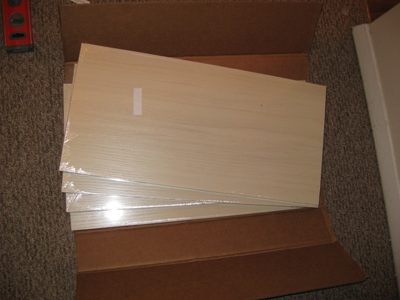
I’d originally planned on four shelves, but only because I completely failed to do basic arithmetic while I was in research mode. When it came time to place the order, we went with five. There are only four in this shot because I was already tearing into the shrink wrap of shelf #1. I may have been cackling gleefully at the time.
There are three options for securing the shelves to the brackets: wire connectors, independent shelf pins, and screws. Several reviews I saw indicated that the wire connectors felt a little loose and flimsy. Using screws would obviously provide the most security, but since we don’t have kids or live in an earthquake-prone area, it seemed like an unnecessary length to go to, so we chose the independent shelf pins. They’re little wedges of clear plastic on a long peg, with smaller pegs sticking out of the widest part of the wedge at a 90° angle. The long peg is inserted into a pre-drilled hole in the shelf and the wedge fits into the shelf bracket, with a smaller pegs slipping into notches in the bracket to prevent the pins from twisting and the shelf from skewing.
The shelves dropped into place on the brackets easily; a gentle squeeze ensured everything was snuggly in place.
The last step was to cut the top track cover to size with a pair of regular scissors, bend the long edges toward each other slightly to get it to fit under the edges of the top track, and apply gentle pressure until it snapped into place.
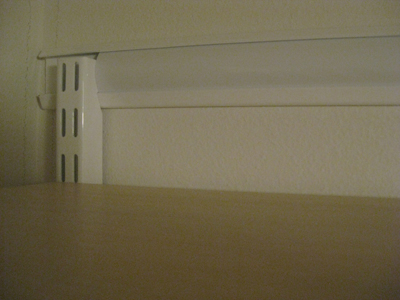
At last, we had a pantry!
Then came the fun part: filling it up. Even after cleaning out our old cart last week, I still found items that I could consolidate into a single container. Once I started putting things on the shelves, I realized that it made more sense to have them at different heights than to keep them evenly spaced. I grouped the shelves that needed less clearance at the bottom, which put more shelves within my reach (I’m only 5’2″). This gave us enough room on the top shelf to move most of Justin’s beer making kit there; I prefer that to store it next to the cleaning supplies on the other wall.
Looking at the pictures, I kind of wish I’d made a gif of the shelves filling up. Live and learn for next time.
Now for my favorite part: the side-by-side comparison of the old, sad space and the new, awesome space:
The blank wall where recyclables used to pile up is now an organized pantry. Speaking of recyclables, the red thing at the bottom of the photo is an Umbra Crunch Can that we picked up on sale at The Container Store while we were returning the unused wood screws that were included in our elfa order and a utility hook for another space that didn’t work out.
Next to the pantry shelves are hooks to hold our Swiffer WetJet and ultra-lightweight ladder. The Swiffer used to live on the back of the laundry room door along with our ironing board. I made the decision to hang them there right after we moved into the apartment, and it made sense to me at the time because I was frequently doing laundry in the dining room (which didn’t have any furniture in it for about 5 months). But we were getting tired of things banging around every time we opened the laundry room door, and we knew it would only get worse once the space started pulling double duty. So I relocated the ironing board to the back of the linen closet door in the hallway, which freed up space for the ladder. New homes for everything!
We still have the cart in the living room, and it’s still hosting the caffeination station. We’ll probably move it into the dining room for now, but I think the ultimate goal is to sell/donate it and replace it with a bar cart that’s a little less visually bulky. Or maybe we’ll find another solution all together.
To celebrate the new pantry, I cooked dinner on Saturday. Justin usually handles the cooking these days since he isn’t working, so it was really nice to get into the kitchen and make something for a change. I foresee many more home-cooked meals to come.
Assignment #10: Clean a Drawer
There are no shortage of drawers in our apartment, but surprisingly enough I feel pretty good about their organization and had trouble picking a candidate for a good cleaning. That’s not to say that some of my drawers aren’t quite full, but I know what’s in all of them and can get to the things I need to without dumping everything on the floor in a mad game of hide-and-seek. So I took the easy way out and cleaned the drawer of the cart from the pantry assignment.
Things that stayed: spare batteries, butane lighters, scissors, straws, small collection of plastic cutlery (corralled in a tray), pack of chalk (for writing the contents on our coffee jars), and a tiny tool kit.
Things that went: extra chopsticks, extra plastic cutlery, a set of four glass coasters that I never use.
A handful of other items got relocated to their proper homes elsewhere in the apartment. I also fixed the drawer itself, which at some point got something wedged into the seam between the back and the bottom of the drawer, causing the bottom to buckle and the drawer to stick. Now the drawer slides easily, and there’s just a single layer of useful items in it. Hardly life-changing, but it’s an improvement.
Assignment #9: Work on Your Project
While I had hoped to be the proud owner of a set of pristine new pantry shelves full of promise and possibility, or at the very least the hopeful owner of several plastic sacks of shelf components, instead I am the slightly crestfallen owner of a packet of papers describing in detail the elfa system I envisioned.
As it turns out, the Container Store doesn’t routinely stock all of the components available for use in the elfa system, and even if they did, they’d probably be sold out due to the very sale that prompted us to undertake this project. So instead of walking in and throwing things into a cart while delightedly checking things off my list, we waited until an associate was available to walk us through the design process. What I thought was a complimentary service provided as a courtesy to people interested in purchasing a shelving system—and perhaps a required step for anyone looking to use their installation service—is actually a necessary step for placing an order for parts. Huh.
Don’t get me wrong, the sales associate was a kind and helpful person who plugged all of our information into the computer and turned it into a proper order as efficiently as possible, and I have no complaints about her service. But having to ask for help when I didn’t really need it sort of took the wind out of my DIY sails, you know? And while she was quite speedy, it still took longer than I’d planned, which I suppose is just one of many, many reminders I’m going to get about how few home projects are done within the original schedule and/or budget.
Anyway, everything should arrive neatly shrink-wrapped at our local store this Saturday. Whether we get it all installed Saturday or Sunday will depend on how late in the day we have to pick it up. But by Monday, there will be no more non-perishables in my living room. I can hardly wait!
Assignment #8: The Power of the Surface Sweep
I do a surface sweep one to two times a week, but usually it’s at the point where I’m already starting to feel bothered by the clutter that’s accumulating: four or five days’ worth of mail, a couple of glasses that were filled right after the dishwasher got loaded, stray pens or a pair of scissors, and, since we’re in the winter months, a scarf (or three) draped hither or thither. I’d like to get in the habit of doing it every day or at least every other day, to avoid that build-up of daily detritus that tends to fester into a Mess (and all-too-often ends up a Total Disaster). I’ve seen three strategies to do this quickly:
- Make a series of passes through the whole apartment, dealing with one type of item on each pass. This is my usual method, and I find it’s really helpful for getting all of the wayward dishes and stray socks end up in their respective loads for cleaning. It does mean retracing your steps a lot, though.
- Grab a basket, put everything that’s out of place in it, and then make a stop in each room to put things back. I’ve never actually done this, but I know some people love it. It saves walking back and forth through the whole house ten times, but I worry that I’d end up with so much stuff in the basket that I’d have to spend time sorting everything out in each room. A side benefit of this approach is that if you get interrupted mid-tidy, you can just shove the basket out of sight. (Of course, the drawback to that is that it’s easy to get in the habit of just shoving things into a closet rather than finding a permanent home for them. See: my office closet right now.)
- Grab things from the room you’re in now, take them to the room they belong in, and pick up fresh things when you get there. I do this from time to time, usually when there are just a few stray things, and usually when I’m cleaning up between larger tasks like waiting for water to boil. Although not terribly efficient, it can be oddly motivating, since each time you’re in a different room you’re challenged to find something to put away. And if you’re like us, there’s always something.
Do you use just one of these methods, or some combination of the three? Do you have a tidying strategy you swear by?

